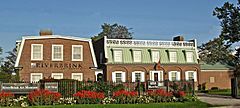RiverBrink Art Museum facts for kids
 |
|
| Location | 116 Queenston St, Queenston, Niagara-on-the-Lake Ontario, Canada |
|---|---|
| Type | Art museum |
The RiverBrink Art Museum is a cool place to visit in the historic village of Queenston. This village is part of Niagara-on-the-Lake, a beautiful area in Canada. The museum first opened its doors to the public in 1983. It holds a special collection of over 1,400 artworks. These pieces come from both Canadian and international artists.
Contents
What You'll Find at RiverBrink
The museum's collection is quite amazing. It includes many different types of art. You can see paintings, prints, and sculptures. There are also works on paper and decorative art pieces. The museum even has old documents and rare books.
The Samuel E. Weir Collection
Most of the art was collected by Samuel E. Weir. He was a lawyer from Ontario. Mr. Weir loved art and collected it throughout his life. The museum still adds to its collection today. They get new pieces through gifts and by buying them.
Art Inspired by Niagara
The museum's location in Niagara was very important to Mr. Weir. Because of this, many artworks show Niagara Falls. You can also see scenes from the Niagara area in the collection.
Famous Artists on Display
RiverBrink has paintings by many important Canadian artists. These include Tom Thomson and Homer Watson. You can also see works by Emily Carr and members of the Group of Seven. The museum also features art by well-known artists from other countries. Some of these are Mary Cassatt and Edgar Degas.
Other Collections
Beyond paintings, the museum has a large collection of decorative arts. This includes English and Québec silver. You can also see old clocks and antique furniture. There are Indian medals, coins, rugs, and ceramics too. The museum's library and archives are also huge. They hold over 4,000 books. There are also personal letters, maps, and records from art sales. You can even find files on hundreds of different artists.
Seeing the Art
The museum often creates new exhibitions. These shows use art from their own collection. They also borrow pieces from other museums and private collectors. If you want to explore the RiverBrink collection, you can search online. Just visit the Canadian Heritage Information Network’s Artefacts Canada: Humanities database.
The Story of RiverBrink
Samuel E. Weir was born in London, Ontario, in 1898. He studied law in Toronto. He became a lawyer in Ontario in 1920. His interest in art began in the early 1920s. He bought a watercolour painting by an English artist named Dame Laura Knight.
A Lifelong Passion for Art
Soon after, he discovered a painting by Homer Watson. It was called The Lothian Hills (1892). Mr. Weir bought it directly from the artist. He paid for it in parts over time. He often bought art this way. Even after buying many more artworks, Watson's painting remained his favorite. Samuel Weir passed away in 1981. He left his art collection and his property to the Weir Foundation. This foundation was started in 1962.
The Museum Building
Mr. Weir bought the land in Queenston in 1943. He started building his home there in the late 1950s. The house and a separate coach house were designed by Arthur E. Nutter. He was an English-born architect and a family friend. Mr. Nutter was the first architect to work in London, Ontario.
Weir's Influence on Design
Mr. Weir played a big part in designing his home. He asked for special features. For example, he wanted a fall-out shelter in the basement. He also wanted a separate apartment above the coach house. For the main house, Nutter used a Georgian-style design. This style included a mansard roof and gabled windows.
Inside the Museum
The rooms inside the museum still have their original wood paneling. A carpenter named Alexander Kiss installed it. He used many different kinds of wood. These included maple, mahogany, oak, and walnut. The ceilings were made of clear pine and birch. The house was finished in 1970. After Mr. Weir's death, it was turned into an art museum. In 1996, a large porch on the east side was replaced. This created more space for art exhibitions.
Images for kids
-
James B. Dennis, Battle of Queenston Heights, c. 1812–55




